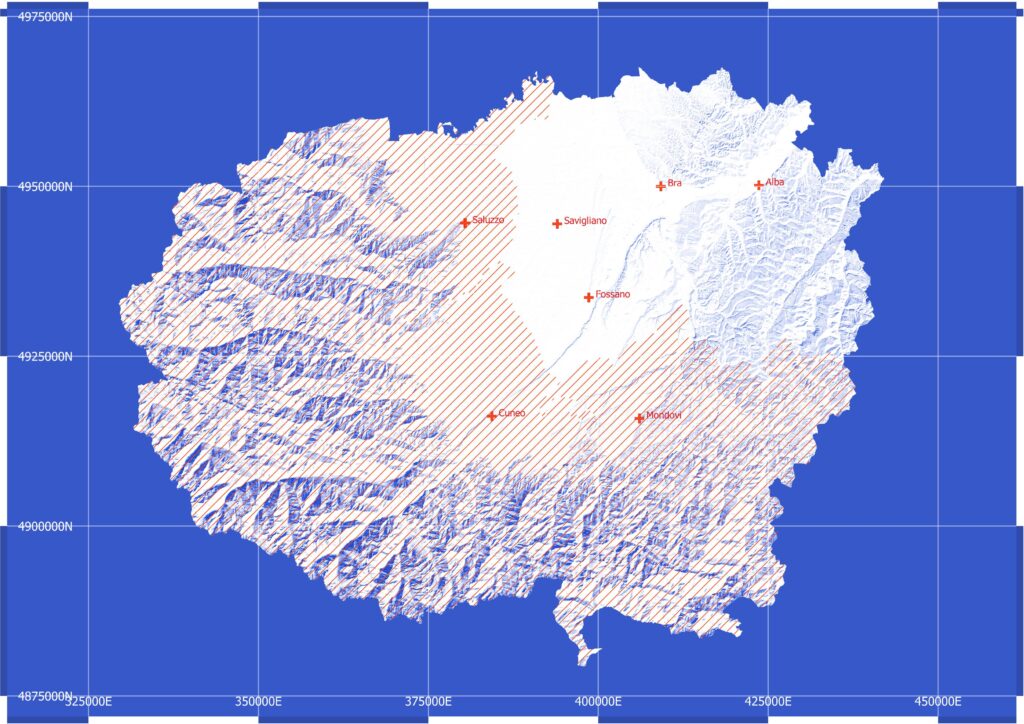Mezzaluna alpina
"Alpine crescent" - Surveys in and for the Metromontane Territory
Indagini per il territorio metromontano
Il Cuneese è caratterizzato da una ricca conformazione orografica, definita dall’originale relazione tra il sistema montano e la pianura, dove si concentrano i principali nodi urbani. La morfologia ad arco, che ricorda una mezzaluna, si traduce in un sistema vallivo disposto a pettine lungo il profilo occidentale e meridionale, nel punto in cui le Alpi si piegano, segnando la discontinuità tra Piemonte e Liguria. Le città di Saluzzo, Cuneo e Mondovì, insieme alle aree di fondovalle, mantengono un forte legame funzionale, culturale e simbolico con le valli circostanti, delineando una marcata identità metromontana.
In questo contesto, l’area della Mezzaluna Alpina si configura come un laboratorio per l’osservazione di pratiche emergenti e la costruzione di scenari di “nuova montagna”. Con questo obiettivo, il Politecnico di Torino ha avviato una collaborazione con il Comune di Cuneo per analizzare le dinamiche in atto, delineare prospettive di sviluppo e individuare criticità e opportunità, promuovendo una visione integrata fondata su processi strategici e negoziali.

La ricerca “Mezzaluna Alpina” indaga le trasformazioni sociali, economiche e territoriali dell’arco alpino cuneese, a partire dalle complesse interazioni tra aree urbane e montane. Attraverso analisi quantitative e indagini qualitative, il progetto esplora le pratiche quotidiane di vita, lavoro e mobilità, nonché le percezioni e le aspirazioni degli abitanti. Il report Mezzaluna Alpina – Dinamiche e prospettive dei territori metromontani raccoglie i risultati di questo percorso di ascolto e analisi, a supporto della definizione di scenari strategici per lo sviluppo sostenibile e la valorizzazione del territorio.

I risultati del lavoro, sviluppati in collaborazione con l’Assessorato alla Metromontagna del Comune di Cuneo, comprendono la produzione di mappe sugli spostamenti degli abitanti, l’analisi delle percezioni della montagna e l’individuazione di figure chiave per approfondire le questioni strategiche, contribuendo alla costruzione di una nuova visione per la montagna contemporanea.
Scarica qui il report della ricerca.
Alpine Crescent – Investigations for the Metromountain Territory
The Cuneo area is characterized by a rich orographic structure, defined by the unique relationship between its mountainous system and the plain, where the main urban centers are located. Its crescent-shaped morphology is reflected in a comb-like valley system that stretches along the western and southern edges, where the Alps curve and mark a discontinuity between Piedmont and Liguria. The cities of Saluzzo, Cuneo, and Mondovì, together with the valley floor areas, maintain a strong functional, cultural, and symbolic connection with the surrounding valleys, shaping a distinct metromountain identity.
In this context, the ‘Alpine Crescent’ emerges as a living laboratory for observing emerging practices and envisioning scenarios for a ‘new mountain’. With this aim, the Politecnico di Torino launched a collaboration with the Municipality of Cuneo to analyze ongoing dynamics, outline development perspectives, and identify challenges and opportunities—promoting an integrated vision based on strategic and negotiated processes.
The ‘Alpine Crescent’ research project investigates the social, economic, and territorial transformations of the Cuneo alpine arc, focusing on the complex interactions between urban and mountain areas. Through quantitative data analysis and qualitative fieldwork, the project explores everyday practices of living, working, and mobility, as well as local perceptions and aspirations. The report “Mezzaluna alpina – Dynamics and Prospects of Metromountain Territories” presents the outcomes of this comprehensive listening and analysis process, supporting the development of strategic scenarios for sustainable growth and the enhancement of local resources.
The results, developed in collaboration with the Municipality of Cuneo and specifically with the Department for Metromountain Areas, include mapping residents’ mobility patterns, identifying emerging perceptions of the mountain, and highlighting key figures to deepen strategic issues—contributing to the construction of new visions for the contemporary mountain.
Year
2024 - 2025
Referenti scientifici / Scientific direction
Loris Antonio Servillo, Antonio De Rossi
Coordinamento scientifico / Scientific coordination
Team di ricerca / Research team
Hanno collaborato anche / other contributions
Christian Gerome Cabanilla, Lorenzo Fortunato, Marina Monti Borgioni, Martina Labella
Coordinamento operativo / Operative manager
Ente finanziatore / funding body
Comune di Cuneo
Departments
DAD, DIST
Type
Research project